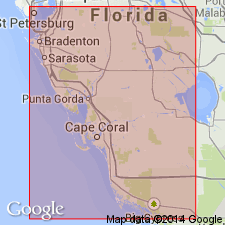
- Usage in publication:
-
- Ochopee Limestone Member
- Modifications:
-
- Named
- Dominant lithology:
-
- Limestone
- AAPG geologic province:
-
- South Florida province
Summary:
Ochopee Limestone Member of Tamiami Formation named in southern FL. Unit is 9 m of white fossiliferous limestone at type section. Overlies Buckingham Limestone Member.
Source: GNU records (USGS DDS-6; Reston GNULEX).

- Usage in publication:
-
- Ochopee Limestone Member
- Modifications:
-
- Revised
- AAPG geologic province:
-
- Florida platform
Summary:
Sarasota Formation of Tamiami Group (rank raised) subdivided into Myakka, Buckingham Limestone, Ochopee Limestone, Forty Mile Bend Members and coral/mollusk biohermal facies. Ochopee Limestone Member described as a light gray calcarenite.
Source: GNU records (USGS DDS-6; Reston GNULEX).
For more information, please contact Nancy Stamm, Geologic Names Committee Secretary.
Asterisk (*) indicates published by U.S. Geological Survey authors.
"No current usage" (†) implies that a name has been abandoned or has fallen into disuse. Former usage and, if known, replacement name given in parentheses ( ).
Slash (/) indicates name conflicts with nomenclatural guidelines (CSN, 1933; ACSN, 1961, 1970; NACSN, 1983, 2005, 2021). May be explained within brackets ([ ]).

